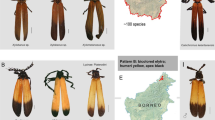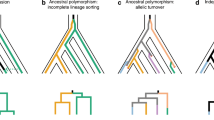Abstract
DEFENSIVE mimicry has long been a paradigm of adaptive evolution by natural selection1–3. Mimics, models and predators in a batesian mimicry system (unpalatable model, palatable mimic) exist in a very different selective milieu from those in a müllerian system (involving ≳2 unpalatable 'co-models')1,4–6. Consequently, the incorrect characterization of a mimicry relationship obscures the natural histories of populations involved and undermines attempts to test general mimicry theory by means of empirical studies of specific systems. Here, we reassess the classic case of mimicry involving viceroy butterflies, Limenitis archippus (Cramer) (Nymphalidae), and two species they purportedly mimic: the monarch, Danaus plexippus (L.), and the queen, Danaus gilippus (Cramer) (Nymphalidae: Danainae). Viceroys are historically considered palatable (batesian) mimics7,8 of the chemically defended9 danaines. Our experiment refutes this interpretation by revealing that viceroys are as unpalatable as monarchs, and significantly more unpalatable than queens from representative Florida populations. This implies that viceroys are müllerian co-mimics of the danaines and prompts a comprehensive reassessment of this widely cited exemplar of mimicry.
This is a preview of subscription content, access via your institution
Access options
Subscribe to this journal
Receive 51 print issues and online access
$199.00 per year
only $3.90 per issue
Buy this article
- Purchase on Springer Link
- Instant access to full article PDF
Prices may be subject to local taxes which are calculated during checkout
Similar content being viewed by others
References
Turner, J. R. G. Ecol. Ent. 12, 81–95 (1987).
Vane-Wright, R. I. Biol. J. Linn. Soc. Lond. 16, 33–40 (1981).
Brower, L. P. Am. Nat. 131 (suppl.), 1–3 (1988).
Ford, E. B. Ecological Genetics (Methuen, London, 1971).
Rothschild, M. Symb. Bot. Uppsal. 22, 82–99 (1979).
Huheey, J. E. Am. Nat. 131, S22–S41 (1988).
Walsh, B. D. & Riley, C. V. Am. Ent. 1, 189–193 (1869).
Scudder, S. H. Nature 3, 147 (1970).
Brower, L. P. in The Biology of Butterflies (eds Vane-Wright, R. I. & Ackery, P. R.) 109–135 (Symp. Roy. Ent. Soc. No. 11).
Cohen, J. A. J. chem. Ecol. 11, 85–103 (1985).
Malcolm, S. B., Cockrell, B. J. & Brower, L. P. J. chem. Ecol. 15, 819–854 (1989).
Glendinning, J. I. thesis, Univ. of Florida (1989).
Kelley, R. B., Seiber, J. N., Jones, A. D., Segall, H. J. & Brower, L. P. Experientia 43, 943–946 (1987).
Brower, J. V. Z. Evolution 12, 32–47 (1958).
Brower, J. V. Z. Evolution 12, 273–285 (1958).
Platt, A. P., Coppinger, R. P. & Brower, L. P. Evolution 25, 692–701 (1971).
Pliske, T. E. Environ. Ent. 4, 455–473 (1975).
Bent, A. C. Life Histories of North American Blackbirds, Orioles, Tanagers, and Allies (Dover New York, 1965).
Brower, L. P. & Brower, J. V. Z. Nat. Hist. 71, 8–19 (1962).
Rothschild, M., Mummery, R. & Farrell, C. Biol. J. Linn. Soc. Lond. 28, 359–372 (1986).
Ackery, P. R. & Vane-Wright, R. I. Milkweed Butterflies: Their Cladistics and Biology (Cornell Univ. Press, New York, 1984).
Wunderlin, R. P. Guide to the Vascular Plants of Central Florida (University Presses of Florida Tampa, 1982).
Turner, J. R. G., Kearney, E. P. & Exton, L. S. Biol. J. Linn. Soc. Lond. 23, 247–268 (1984).
Huheey, J. E. Evolution 30, 86–93 (1976).
Turner, J. R. G. Zool. J. Linn. Soc. 58, 297–308 (1976).
Sbordoni, V., Bullini, L., Scarpelli, G., Forestiero, S. & Rampini, M. Ecol. Ent. 4, 83–93 (1979).
Day, R. W. & Quinn, G. P. Ecol. Monogr. 59, 433–463 (1989).
Author information
Authors and Affiliations
Rights and permissions
About this article
Cite this article
Ritland, D., Brower, L. The viceroy butterfly is not a batesian mimic. Nature 350, 497–498 (1991). https://doi.org/10.1038/350497a0
Received:
Accepted:
Issue Date:
DOI: https://doi.org/10.1038/350497a0
This article is cited by
-
Psychological Aposematism: An Evolutionary Analysis of Suicide
Biological Theory (2020)
-
Mimicry in viceroy butterflies is dependent on abundance of the model queen butterfly
Communications Biology (2019)
-
The Mechanism for Mimicry: Instant Biosemiotic Selection or Gradual Darwinian Fine-Tuning Selection?
Biosemiotics (2019)
-
CRISPR reveals genetic master switches behind butterfly wing patterns
Nature (2017)
-
The genetics of monarch butterfly migration and warning colouration
Nature (2014)
Comments
By submitting a comment you agree to abide by our Terms and Community Guidelines. If you find something abusive or that does not comply with our terms or guidelines please flag it as inappropriate.



